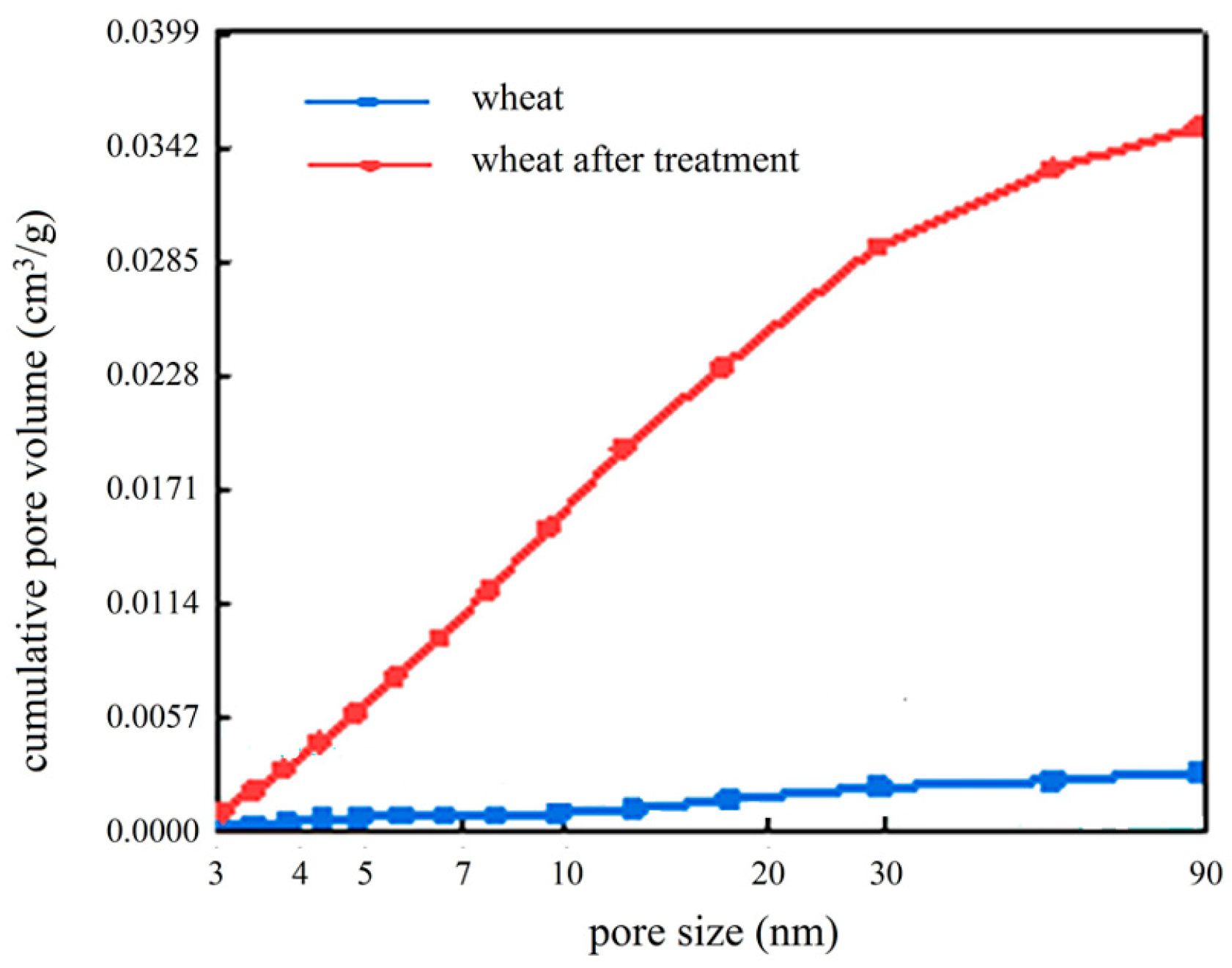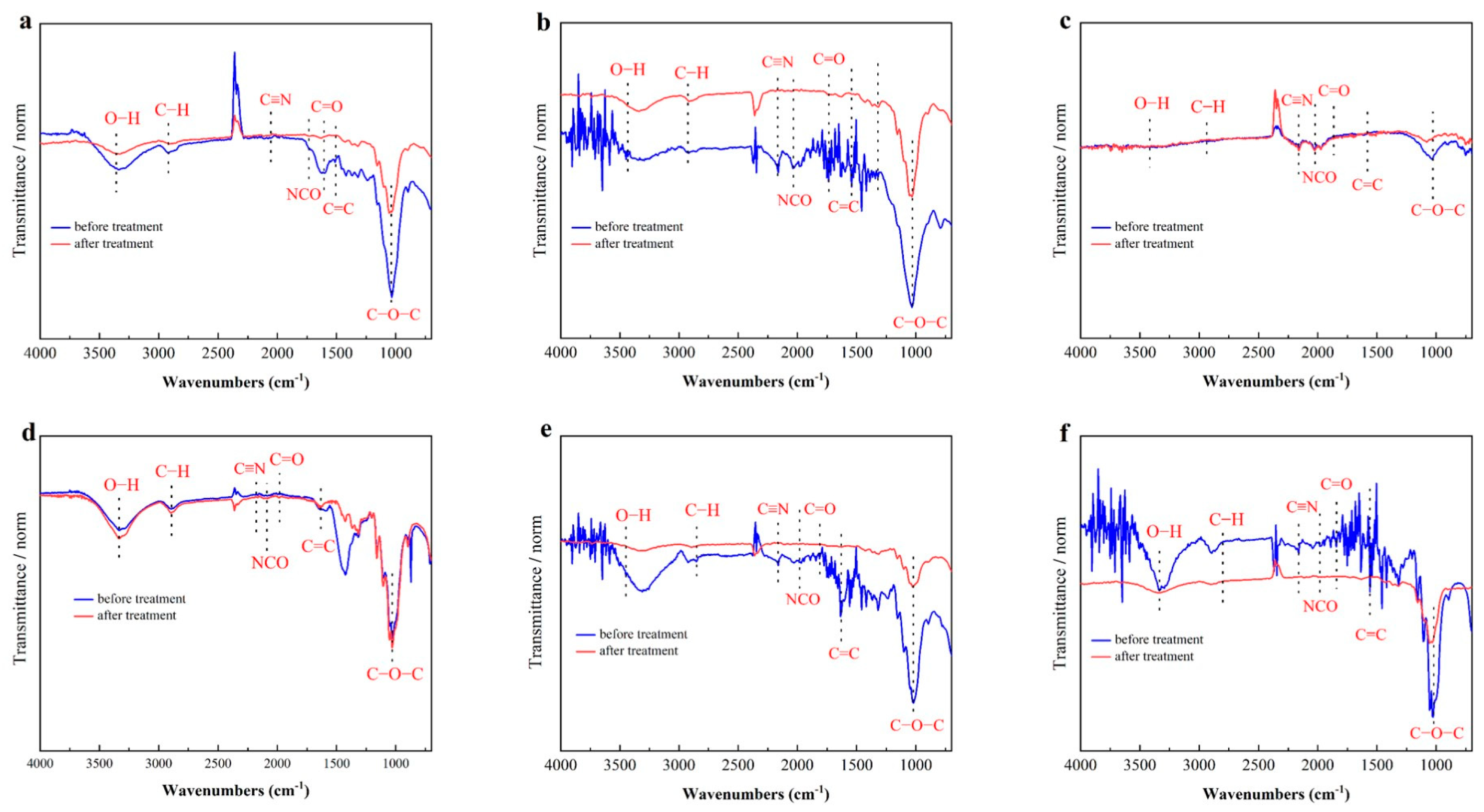Preliminary Investigation into the Use of Amino-Acid-Derived Ionic Liquids for Extracting Cellulose from Waste Biomass to Prepare Cellulose Aerogel Adsorbents
Abstract
1. Introduction
2. Results and Discussion
2.1. Effect of Pre-Treatment on Biomass
2.1.1. Microstructure of Biomass
2.1.2. Chemical Composition of Biomass
2.2. Properties of Aerogels
3. Conclusions
4. Materials and Methods
4.1. Materials
4.2. Methods
4.2.1. Pre-Treatment of Materials
4.2.2. Synthesis of Aerogels
4.2.3. Static Adsorption Experiments
4.2.4. Methods for the Determination of Lignocellulose Content
4.3. Characterization
Author Contributions
Funding
Institutional Review Board Statement
Informed Consent Statement
Data Availability Statement
Conflicts of Interest
References
- Chen, D.Y.; Zhu, H.G.; Yang, S.; Li, N.; Xu, Q.; Li, H.; He, J.; Lu, J. Micro-Nanocomposites in Environmental Management. Adv. Mater. 2016, 28, 10443–10458. [Google Scholar] [CrossRef]
- Yap, P.L.; Nine, J.; Hassan, K.; Tung, T.T.; Tran, D.N.; Losic, D. Graphene-Based Sorbents for Multipollutants Removal in Water: A Review of Recent Progress. Adv. Funct. Mater. 2021, 31, 25. [Google Scholar] [CrossRef]
- Wang, H.B.; Zhang, Y.F.; Xiong, J.Q.; Zhang, D.; Lin, H.; Chen, Y. Regenerated cellulose microspheres-aerogel enabled sustainable removal of metal ions for water remediation. J. Mater. Sci. 2022, 57, 8016–8028. [Google Scholar] [CrossRef]
- Chen, Y.M.; Zhang, L.; Yang, Y.; Pang, B.; Xu, W.; Duan, G.; Jiang, S.; Zhang, K. Recent Progress on Nanocellulose Aerogels: Preparation, Modification, Composite Fabrication, Applications. Adv. Mater. 2021, 33, 34. [Google Scholar] [CrossRef] [PubMed]
- French, A.D. Glucose, not cellobiose, is the repeating unit of cellulose and why that is important. Cellulose 2017, 24, 4605–4609. [Google Scholar] [CrossRef]
- Li, M.M.; Wu, Z.Q.; Chen, X.; Gan, F.; Teng, C.; Li, X.; Dong, J.; Zhao, X.; Zhang, Q. Continuous and strong polyimide aerogel fibers enhanced by para-aramid nanofibers prepared a “Reaction Spinning” for thermal insulation. Chem. Eng. J. 2024, 486, 8. [Google Scholar] [CrossRef]
- Li, X.Z.; Wan, C.C.; Tao, T.; Chai, H.; Huang, Q.; Chai, Y.; Wu, Y. An overview of the development status and applications of cellulose-based functional materials. Cellulose 2024, 31, 61–99. [Google Scholar] [CrossRef]
- Liang, Y.Q.; Jian, H.; Deng, C.; Xu, J.; Liu, Y.; Park, H.; Wen, M.; Sun, Y. Research and Application of Biomass-Based Wood Flame Retardants: A Review. Polymers 2023, 15, 17. [Google Scholar] [CrossRef]
- Deng, W.P.; Feng, Y.C.; Fu, J.; Guo, H.; Guo, Y.; Han, B.; Jiang, Z.; Kong, L.; Li, C.; Liu, H.; et al. Catalytic conversion of lignocellulosic biomass into chemicals and fuels. Green. Energy Environ. 2023, 8, 10–114. [Google Scholar] [CrossRef]
- Fan, S.T.; Gao, X.; Yang, X.; Li, X. Infusing phytate-based biomass flame retardants into the cellulose lumens of Chinese fir wood attains superior flame retardant efficacy. Int. J. Biol. Macromol. 2024, 258, 10. [Google Scholar] [CrossRef]
- Xiong, J.Q.; Zhang, D.S.; Lin, H.; Chen, Y. Amphiprotic cellulose mediated graphene oxide magnetic aerogels for water remediation. Chem. Eng. J. 2020, 400, 9. [Google Scholar] [CrossRef]
- Zhou, X.M.; Fu, Q.G.; Liu, H.; Gu, H.; Guo, Z. Solvent-free nanoalumina loaded nanocellulose aerogel for efficient oil and organic solvent adsorption. J. Colloid. Interface Sci. 2021, 581, 299–306. [Google Scholar] [CrossRef]
- Sun, Y.; Chu, Y.L.; Wu, W.B.; Xiao, H. Nanocellulose-based lightweight porous materials: A review. Carbohydr. Polym. 2021, 255, 19. [Google Scholar] [CrossRef] [PubMed]
- Gupta, S.; Saud, A.; Munira, N.; Allal, A.; Preud’Homme, H.; Shomar, B.; Zaidi, S.J. Removal of heavy metals from wastewater by aerogel derived from date palm waste. Environ Res. 2024, 245, 13. [Google Scholar] [CrossRef]
- Dilamian, M.; Noroozi, B. Rice straw agri-waste for water pollutant adsorption: Relevant mesoporous super hydrophobic cellulose aerogel. Carbohydr. Polym. 2021, 251, 13. [Google Scholar] [CrossRef]
- Akhlamadi, G.; Goharshadi, E.K. Sustainable and superhydrophobic cellulose nanocrystal-based aerogel derived from waste tissue paper as a sorbent for efficient oil/water separation. Process Saf. Environ. Prot. 2021, 154, 155–167. [Google Scholar] [CrossRef]
- Sun, X.; Sun, X.; Zhang, F. Combined pretreatment of lignocellulosic biomass by solid base (calcined Na2SiO3) and ionic liquid for enhanced enzymatic saccharification. RSC Adv. 2016, 6, 99455–99466. [Google Scholar] [CrossRef]
- Hu, X.M.; Wang, F.L.; Ma, H.H.; Zhang, B.X.; Gao, Y.F.; Hu, B.Z. Factors governing the pretreatment process of lignocellulosic biomass in an acidic pyrrolidonium ionic liquid. Bioresources 2016, 11, 9896–9911. [Google Scholar] [CrossRef]
- De Gregorio, G.F.; Weber, C.C.; Grasvik, J.; Welton, T.; Brandt, A.; Hallett, J.P. Mechanistic insights into lignin depolymerisation in acidic ionic liquids. Green. Chem. 2016, 18, 5456–5465. [Google Scholar] [CrossRef]
- Jia, Y.; Nian, S.; Zhao, W.; Fu, L.; Zhang, X.; Beadham, I.; Zhao, S.; Zhang, C.; Deng, Y. Pretreatment of wastepaper with an aqueous solution of amino acid-derived ionic liquid for biochar production as adsorbent. J. Enviro. Manag. 2024, 360, 121195. [Google Scholar] [CrossRef]
- Tao, G.H.; He, L.; Sun, N.; Kou, Y. New generation ionic liquids: Cations derived from amino acids. Chem. Commun. 2005, 28, 3562–3564. [Google Scholar] [CrossRef]
- Ma, H.H.; Beadham, I.; Ruan, W.Q.; Zhang, C.; Deng, Y. Enhancing rice straw compost with an amino acid-derived ionic liquid as additive. Bioresour Technol. 2022, 345, 9. [Google Scholar] [CrossRef] [PubMed]
- Gao, R.; Liu, X.; Xiong, Z.; Wang, G.; Ai, L. Research progress on detection of foodborne pathogens: The more rapid and accurate answer to food safety. Food Res. Int. 2024, 193, 114767. [Google Scholar] [CrossRef]
- Suciyati, S.W.; Manurung, P.; Sembiring, S.; Situmeang, R. Comparative study of Cladophora sp. cellulose by using FTIR and XRD. J. Phys. Conf. Ser. 2021, 1751, 12075. [Google Scholar] [CrossRef]
- Sorn, V.; Chang, K.; Phitsuwan, P.; Ratanakhanokchai, K.; Dong, C.D. Effect of microwave-assisted ionic liquid/acidic ionic liquid pretreatment on the morphology, structure, and enhanced delignification of rice straw. Bioresour. Technol. 2019, 293, 121929. [Google Scholar] [CrossRef] [PubMed]
- Asadieraghi, M.; Wan Daud, A.W.M. Characterization of lignocellulosic biomass thermal degradation and physiochemical structure: Effects of demineralization by diverse acid solutions. Energy Convers. Manag. 2014, 82, 71–82. [Google Scholar] [CrossRef]
- Sun, R.C.; Tomkinson, J. Characterization of hemicelluloses obtained by classical and ultrasonically assisted extractions from wheat straw. Carbohydr. Polym. 2002, 50, 263–271. [Google Scholar] [CrossRef]
- Boeriu, C.G.; Bravo, D.; Gosselink, R.J.; van Dam, J.E. Characterisation of structure-dependent functional properties of lignin with infrared spectroscopy. Ind. Crops Prod. 2004, 20, 205–218. [Google Scholar] [CrossRef]
- Zhu, L.; Tong, L.H.; Zhao, N. Coupling interaction between porous biochar and nano zero valent iron_nano α-hydroxyl iron oxide improves the remediation efficiency of cadmium in aqueous solution. Chemosphere 2019, 219, 493–503. [Google Scholar] [CrossRef]
- Annunciado, T.R.; Sydenstricker, T.H.D.; Amico, S.C. Experimental investigation of various vegetable fibers as sorbent materi-als for oil spills. Mar. Pollut. Bull. 2005, 50, 1340–1346. [Google Scholar] [CrossRef]
- Li, Y.F.; Liu, J.B.; Li, W.J.; Dou, M.; Ma, L.; Wang, Q.; Zhao, B.; Chen, G. Enhanced Sorption for the Oil Spills by SDS-Modified Rice Straw. Gels 2023, 9, 285. [Google Scholar] [CrossRef] [PubMed]
- Tran, D.T.; Nguyen, S.T.; Do, N.D.; Thai, N.N.T.; Thai, Q.B.; Huynh, H.K.P.; Nguyen, V.T.T.; Phan, A.N. Green aerogels from rice straw for thermal, acoustic insulation and oil spill cleaning applications. Mater. Chem. Phys. 2020, 253, 0254–0584. [Google Scholar] [CrossRef]
- Do, N.H.N.; Luu, T.P.; Thai, Q.B.; Le, D.K.; Chau, N.D.Q.; Nguyen, S.T.; Le, P.K.; Phan-Thien, N.; Duong, H.M. Advanced fabrication and application of pineapple aerogels from agricultural waste. Mater. Technol. 2020, 35, 1066–7857. [Google Scholar] [CrossRef]
- Oliveira, P.B.; Godinho, M.; Zattera, A.J. Oils sorption on hydrophobic nanocellulose aerogel obtained from the wood furniture industry waste. Cellulose 2018, 25, 3105–3119. [Google Scholar] [CrossRef]
- Wang, Z.Q.; Feng, Z.M.; Yang, L.L.; Wang, M. Effective Removal of Calcium and Magnesium Ions from Water by a Novel Alginate-Citrate Composite Aerogel. Gels 2021, 7, 13. [Google Scholar] [CrossRef]
- Su, H.; Deng, T.; Qiu, W.; Hu, T.; Zheng, X.; Peng, K.; Zhang, Y.; Zhao, Y.; Xu, Z.; Lei, H.; et al. One stone, two birds: An eco-friendly aerogel based on waste pomelo peel cellulose for the efficient adsorption of dyes and heavy metal ions. Int. J. Biol. Macromol. 2024, 273 Pt 1, 132875. [Google Scholar] [CrossRef]
- Wan, L.; Lu, J.; Jiao, Y.; Cao, J.; Sun, Q.; Li, J. Cellulose aerogels from cellulose–NaOH/PEG solution and comparison with different cellulose contents. Mater. Sci. Technol. 2015, 31, 1234–1245. [Google Scholar] [CrossRef]
- Mongeau, R.; Brassard, R. Determination of Neutral Detergent Fiber in Breakfast Cereals: Pentose, Hemicellulose, Cellulose and Lignin Content. J. Food Sci. 1982, 47, 550–555. [Google Scholar] [CrossRef]
- Xie, C.; Liu, S.; Zhang, Q.; Ma, H.; Yang, S.; Guo, Z.X.; Qiu, T.; Tuo, X. Macroscopic-scale preparation of aramid nanofiber aerogel by modified freezing–drying method. ACS Nano 2021, 15, 10000–10009. [Google Scholar] [CrossRef]
- Fan, J.; Li, H.; Tang, S.; Li, B.; Xin, Y.; Hsieh, Y.-L.; Zhou, J. Compensation strategy for constructing high-performance aerogels using acrylamide-assisted vacuum drying and their use as water-induced electrical generators. Chem. Eng. J. 2023, 452 Pt 4, 139685. [Google Scholar] [CrossRef]
- Ganesan, K.; Barowski, A.; Ratke, L. Gas permeability of cellulose aerogels with a designed dual pore space system. Molecules 2019, 24, 2688. [Google Scholar] [CrossRef] [PubMed]




| Cellulose | C | N | H | O | ||
|---|---|---|---|---|---|---|
| wheat straw | before | 42.8% | 32.7% | 1.31% | 4.39% | 31.3% |
| after | 83.8% | 42.8% | 1.56% | 5.91% | 48.9% | |
| corn stalks | before | 46.8% | 30.9% | 1.29% | 4.44% | 33.5% |
| after | 85.9% | 41.1% | 1.55% | 5.93% | 51.1% | |
| rice straw | before | 49.4% | 30.4% | 1.19% | 4.34% | 33.1% |
| after | 93.5% | 41.2% | 1.54% | 5.97% | 50.9% | |
| paper | before | 62.9% | 35.5% | 1.31% | 6.28% | 14.8% |
| after | 89.5% | 40.7% | 1.51% | 7.40% | 24.0% | |
| jute | before | 72.8% | 33.1% | 1.28% | 4.42% | 31.6% |
| after | 94.0% | 38.2% | 1.46% | 5.30% | 40.5% | |
| cotton | before | 89.8% | 34.8% | 1.30% | 4.19% | 28.2% |
| after | 90.8% | 34.9% | 1.40% | 4.27% | 28.4% |
| Best | Na+ | Ca2+ | Mg2+ | Cd2+ | Engine Oil |
|---|---|---|---|---|---|
| aerogel | A-JUTE | A-PAPER | A-JUTE | A-PAPER | A-RICE |
| AC | 11.6 mg/g | 19.9 mg/g | 35.6 mg/g | 13.3 mg/g | 17.7 g/g |
Disclaimer/Publisher’s Note: The statements, opinions and data contained in all publications are solely those of the individual author(s) and contributor(s) and not of MDPI and/or the editor(s). MDPI and/or the editor(s) disclaim responsibility for any injury to people or property resulting from any ideas, methods, instructions or products referred to in the content. |
© 2025 by the authors. Licensee MDPI, Basel, Switzerland. This article is an open access article distributed under the terms and conditions of the Creative Commons Attribution (CC BY) license (https://creativecommons.org/licenses/by/4.0/).
Share and Cite
Deng, Y.; Zhao, Q.; Nian, S.; Sha, Z.; Fu, L.; Beadham, I.; Xiao, X.; Zhang, C. Preliminary Investigation into the Use of Amino-Acid-Derived Ionic Liquids for Extracting Cellulose from Waste Biomass to Prepare Cellulose Aerogel Adsorbents. Gels 2025, 11, 210. https://doi.org/10.3390/gels11030210
Deng Y, Zhao Q, Nian S, Sha Z, Fu L, Beadham I, Xiao X, Zhang C. Preliminary Investigation into the Use of Amino-Acid-Derived Ionic Liquids for Extracting Cellulose from Waste Biomass to Prepare Cellulose Aerogel Adsorbents. Gels. 2025; 11(3):210. https://doi.org/10.3390/gels11030210
Chicago/Turabian StyleDeng, Yun, Qiusheng Zhao, Shuai Nian, Ziyan Sha, Lin Fu, Ian Beadham, Xiaolan Xiao, and Changbo Zhang. 2025. "Preliminary Investigation into the Use of Amino-Acid-Derived Ionic Liquids for Extracting Cellulose from Waste Biomass to Prepare Cellulose Aerogel Adsorbents" Gels 11, no. 3: 210. https://doi.org/10.3390/gels11030210
APA StyleDeng, Y., Zhao, Q., Nian, S., Sha, Z., Fu, L., Beadham, I., Xiao, X., & Zhang, C. (2025). Preliminary Investigation into the Use of Amino-Acid-Derived Ionic Liquids for Extracting Cellulose from Waste Biomass to Prepare Cellulose Aerogel Adsorbents. Gels, 11(3), 210. https://doi.org/10.3390/gels11030210








